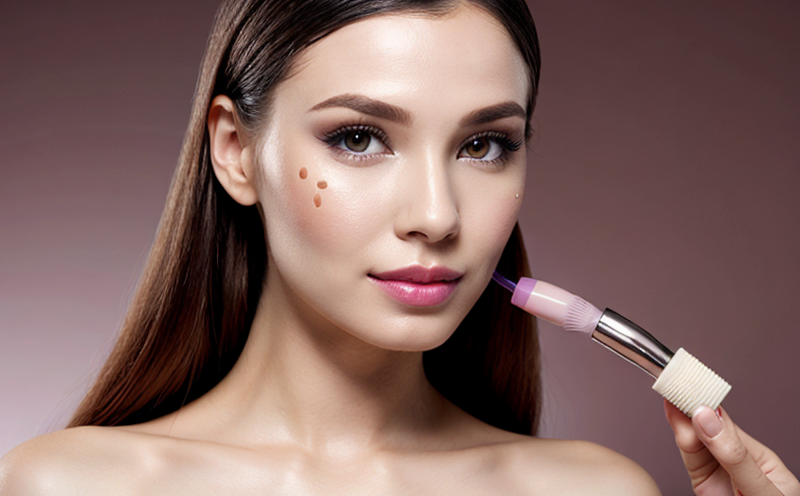In Vitro Testing of Cosmetic Nanoparticles
As the beauty industry continues to evolve with innovative and advanced formulations, ensuring the safety and efficacy of cosmetic nanoparticles has become a critical concern for manufacturers. In-vitro testing represents one of the most precise methods available today to evaluate potential risks associated with these nanoparticles in cosmetics. This service provides comprehensive testing solutions tailored specifically towards the evaluation of nanoparticle-based ingredients used in various cosmetic products.
The process involves using cell cultures or tissues from different parts of the human body, such as skin, hair follicles, and nails, to simulate real-world interactions between the nanoparticles and biological systems. By employing this approach, we can identify potential toxic effects at an early stage without exposing human subjects to harmful substances.
One key advantage of in-vitro testing is its ability to provide reliable data on how nanoparticles behave within specific environments relevant to their intended use. For instance, when assessing dermal penetration, researchers may place cultured skin cells directly into contact with the nanoparticle formulation and observe any migration patterns over time. Additionally, this method allows for repeated experiments under controlled conditions which enhances reproducibility.
Another significant benefit lies in its capacity to help predict adverse reactions more accurately than traditional animal testing methods while adhering strictly to ethical principles promoting humane practices throughout all stages of research & development processes.
In summary, in-vitro testing offers a powerful tool for cosmetic companies looking to ensure their products meet stringent regulatory requirements while also demonstrating commitment towards protecting public health and welfare. The following sections will delve deeper into international recognition, environmental benefits, practical applications, and frequently asked questions regarding this service.
International Acceptance and Recognition
In recent years, there has been growing acceptance of in-vitro testing as part of regulatory compliance across numerous countries around the world. Regulatory bodies such as the European Union (EU), United States Food and Drug Administration (FDA), and others are increasingly adopting this approach due to its advantages over traditional animal models.
The EU Cosmetics Regulation 1272/2005 specifically mandates that certain types of tests must be conducted using alternative methods where available, including in-vitro approaches. Similarly, the FDA's Animal Welfare Act seeks to minimize unnecessary suffering and improve scientific accuracy by encouraging the use of alternatives whenever possible.
Moreover, several international standards organizations have developed guidelines aimed at standardizing these procedures globally. For example:
- ISO/IEC 17025: General requirements for the competence of testing laboratories
- Cosmetic Regulation (EC) No 1272/2005, which includes Annex III on alternative methods
- ASTM E2936-18 Standard Practice for Conducting In Vitro Skin Irritation Testing Using Human Reconstructed Epidermis Models
These standards ensure consistency and reliability in testing protocols, enabling companies to confidently meet global market demands while maintaining high standards of product quality.
Environmental and Sustainability Contributions
- Promoting Ethical Practices: By reducing reliance on animal testing, our in-vitro services contribute significantly to ethical considerations within the industry. This aligns with broader sustainability goals by supporting more compassionate approaches.
- Reducing Waste Streams: Traditional animal testing generates substantial amounts of waste which can be harmful if not properly managed. In contrast, in-vitro methods produce minimal waste and are safer for laboratory staff handling biological samples.
The use of advanced technology allows us to minimize resource consumption during experimentation cycles. Furthermore, by providing accurate results early in the product development process, we enable clients to make informed decisions about ingredient selection and formulation adjustments before reaching large-scale production stages.
Use Cases and Application Examples
| Nanoparticle Type | Application Example |
|---|---|
| Silver Nanoparticles | Antimicrobial efficacy testing for wound care products. |
| Zinc Oxide Nanoparticles | Safety assessment of sunscreens against photocarcinogenesis. |
| Titanium Dioxide Nanoparticles | Evaluation of dermal irritation potential in pigmented cosmetic formulations. |
| Iron Oxide Nanoparticles | Assessing the stability and dispersion behavior of magnetic nanoparticles used in hair treatments. |
In-vitro testing plays a crucial role throughout various stages of product development, from initial concept formulation to final commercial release. Here are some scenarios where this service proves particularly valuable:
- Identifying potential allergens or sensitizers early in the R&D phase.
- Evaluating long-term stability and shelf life predictions based on nanoparticle characteristics.
- Assessing environmental compatibility of nanoparticles through biodegradability studies.





